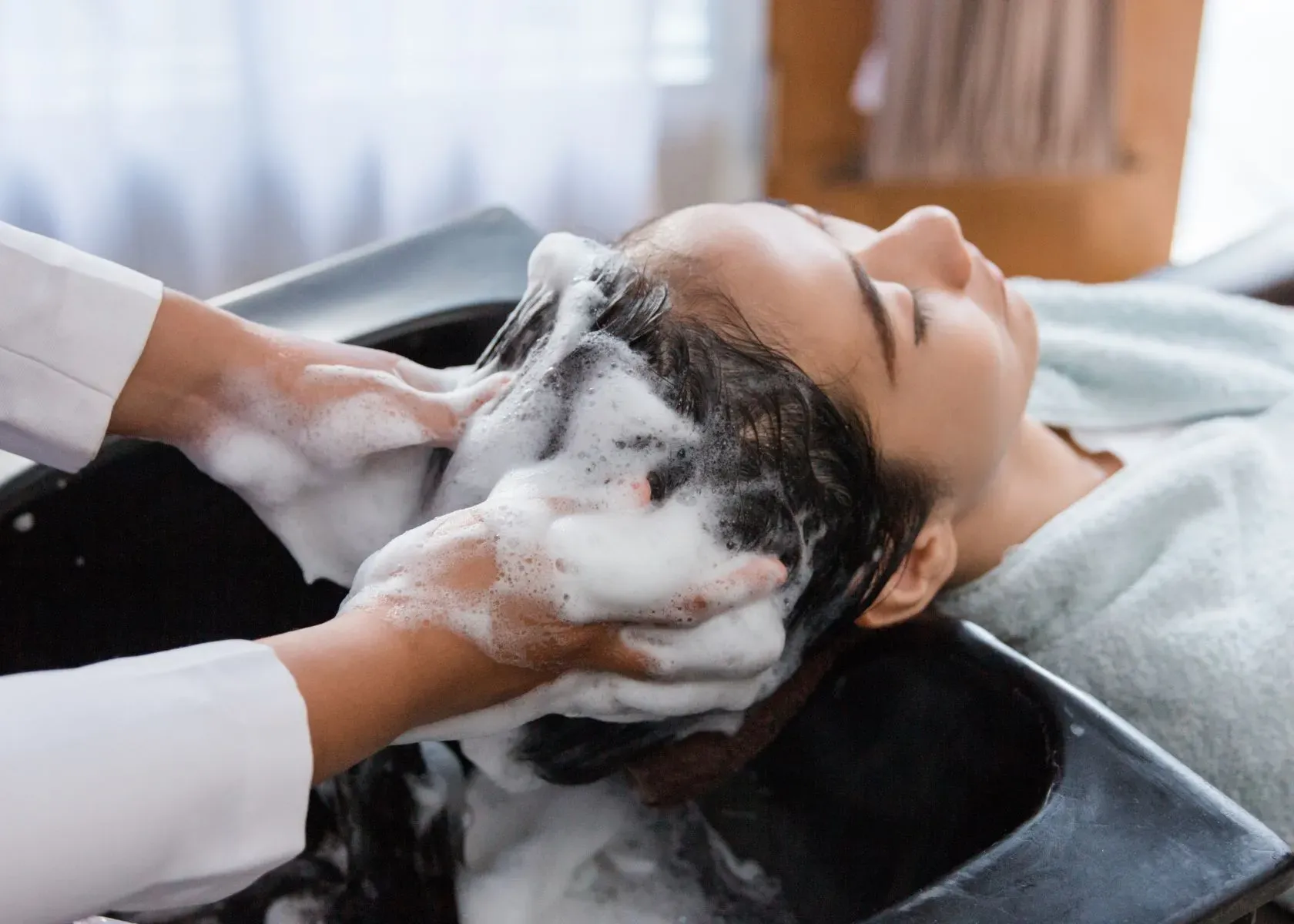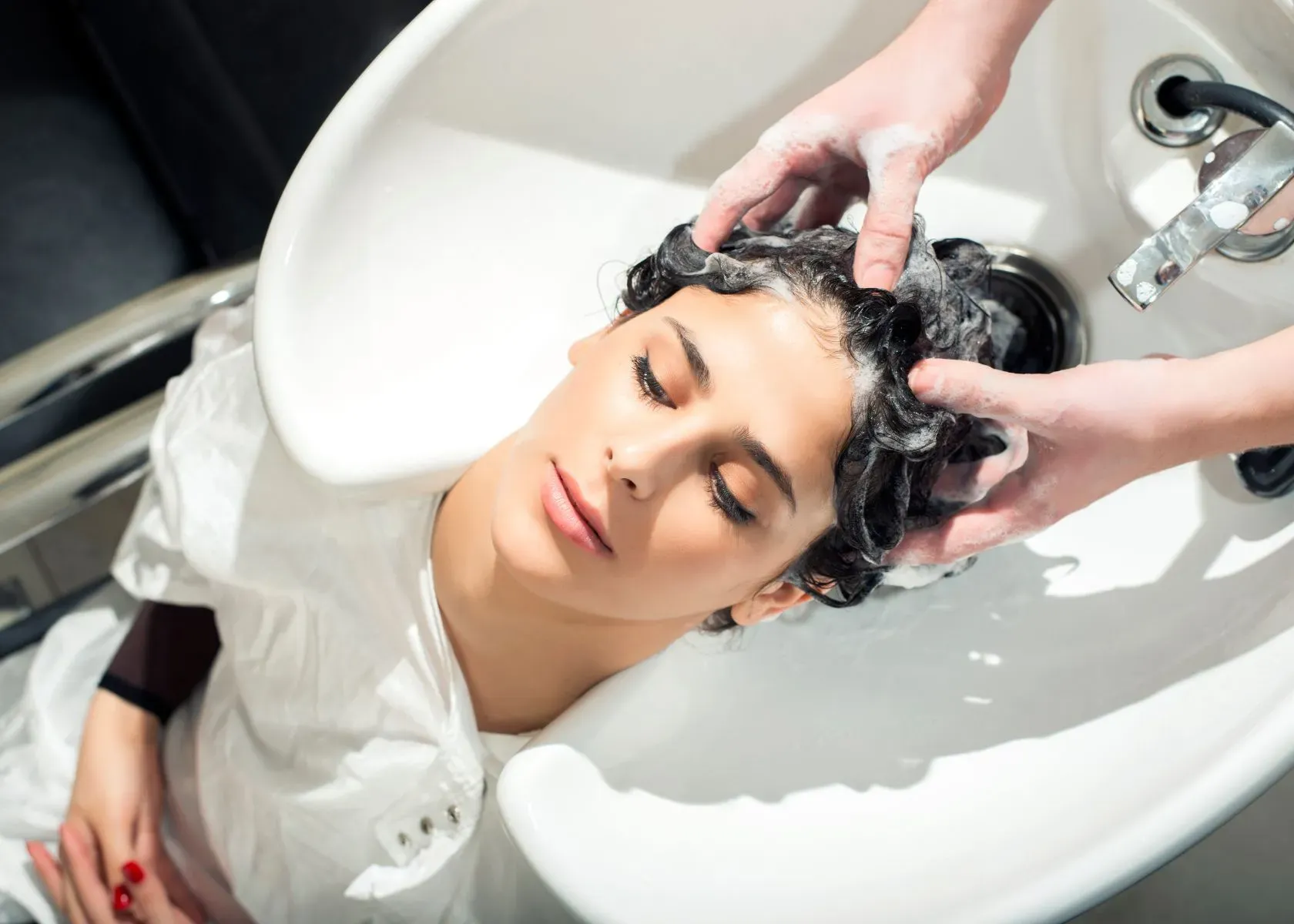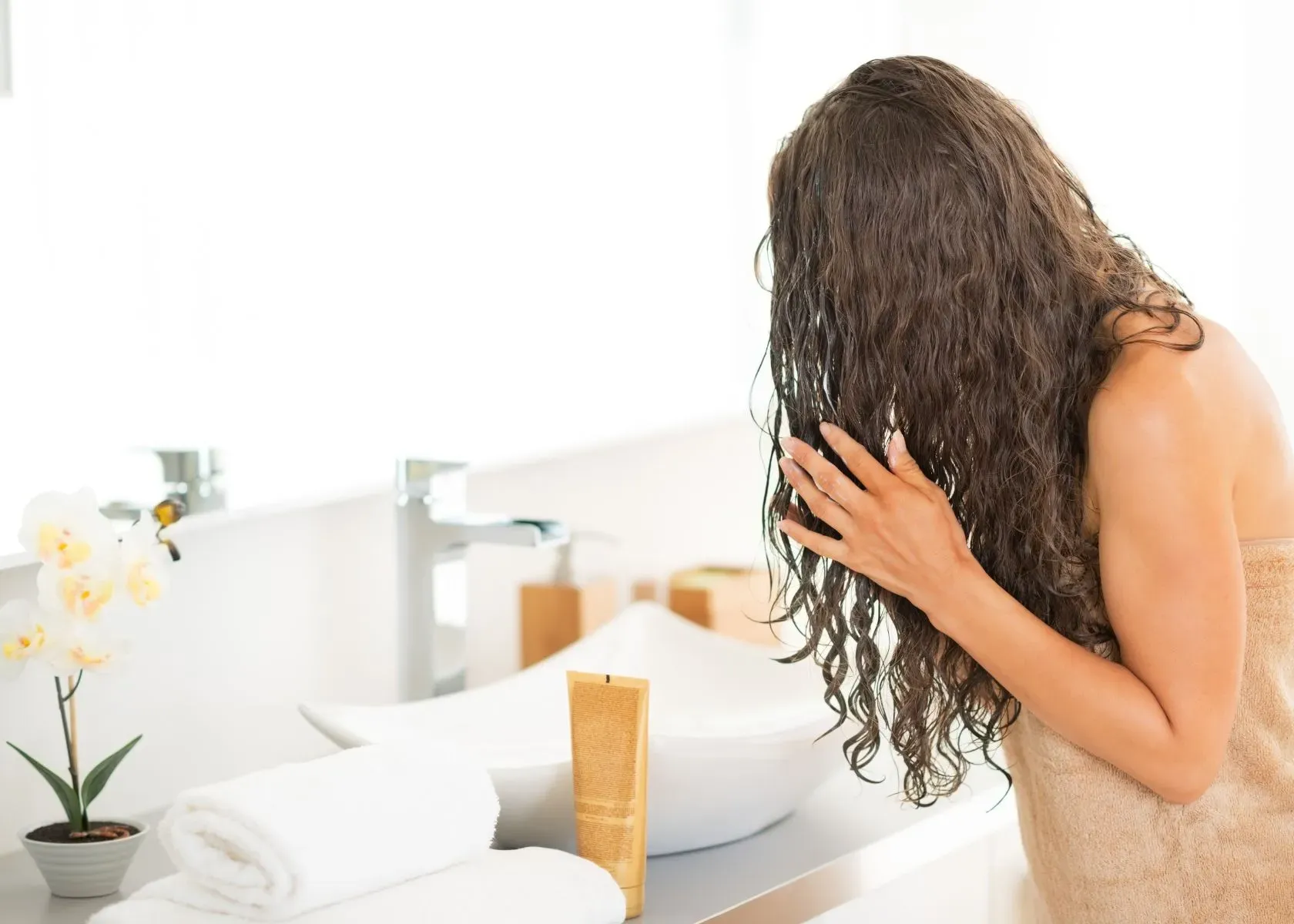Hair bleaching is a process that lightens your hair color by stripping away the pigment with a chemical called bleach. Although it can give you the trendy look you desire, bleaching has side effects, such as making your hair dry and brittle.
If done correctly and safely following instructions, a bleach bath could also be used to change your hair hue without causing too much damage. In this article, we will guide you through removing bleach from your hair while offering expert tips on managing its effects for healthier tresses.
Explore these solutions to keep your bleached locks looking their best.
- Consult a professional stylist for color correction to fix bleached hair; they can use specific products to counteract unwanted tones and restore your natural shade.
- Use deep conditioning treatments regularly, focusing on ones that contain ingredients like keratin, argan oil, or shea butter to repair and nourish bleach-damaged hair.
- Trimming hair frequently can help eliminate dry and split ends caused by bleach, encouraging healthier growth and reducing breakage over time.
- Home remedies such as lemon juice and apple cider vinegar mixtures or mayonnaise masks can naturally aid in removing the effects of bleach while improving hair's condition.
- To manage previously bleached hair long-term, avoid harsh shampoos, minimize heat styling tool usage, and invest in pre-shampoo treatments to strengthen your strands.
Reasons to Remove Bleach From Hair

Hair bleaching involves a chemical reaction that lifts color from the strands of your hair. Bleach works by penetrating the hair shaft and dispersing the color molecules that give your hair its natural hue.
This process can dramatically lighten your locks, resulting in anything from a sun-kissed look to platinum blond.
The key ingredient in most hair bleach is hydrogen peroxide, which reacts with melanin—the pigment responsible for hair's color. As the bleach works, it removes this pigment, but it can also weaken and damage the structure of your hair if not used correctly.
That's why bleached hair often needs extra care to stay healthy and strong.
Deep conditioning becomes crucial after lightening your tresses since it helps improve texture and resilience. Moving on from what bleaching is about, let's delve into how this treatment affects your mane’s health next.
How Does It Affect the Hair?
Hair bleaching affects the hair by stripping away the natural pigment, leading to dryness, brittleness, and breakage. The chemical agents in bleach penetrate the hair cuticle, causing structural damage and weakening the hair strands.
Additionally, excessive bleaching can result in a porous and rough texture, making it more prone to tangling and frizz.
The process of bleaching also opens up the hair shaft, leaving it vulnerable to environmental stressors such as UV radiation and pollution. This can further damage the hair's integrity and lead to color fading over time.
Side Effects of Bleaching on Hair
Bleaching hair can lead to several side effects, such as dryness, frizziness, and breakage. The process strips the natural pigment from the hair, leaving it more vulnerable to damage from environmental factors and styling tools.
Additionally, bleached hair is prone to tangling and may require extra care and maintenance to keep it healthy.
To restore damaged bleached hair, deep conditioning treatments are essential for repairing moisture loss and improving overall hair health. Using mild shampoos during washing can help prevent further damage while avoiding heat styling tools will minimize additional stress on already weakened strands.
4 Methods to Remove Bleach From Hair

Color correction, deep conditioning, haircuts, and keratin hair treatments are effective methods for removing bleach from hair and restoring its natural color and health.
Color Correction
To correct hair color after bleaching, consult a professional stylist for an effective solution. Professional color correction products can help restore your natural hair color or achieve the desired shade.
These products are specifically formulated to counteract the unwanted tones caused by bleaching and provide a balanced, even hair color.
Using at-home toning treatments with purple or blue pigments can help neutralize any brassy or yellow tones in bleached hair. Look for toning shampoos and conditioners designed to maintain cool hues and combat brassiness.
Deep Conditioning
After addressing color correction, deep conditioning is the next crucial step in repairing bleached hair. Deep conditioning treatments replenish moisture, repair damage, and improve the overall health of bleached hair.
By using a deep conditioner once a week, you can help restore your hair's natural shine and strength while combating dryness, brittleness, and breakage caused by the bleaching process.
Look for deep conditioners with ingredients like keratin, argan oil, or shea butter to provide essential nutrients to your hair.
Applying a deep conditioner after each shampoo can make a significant difference in restoring the health of your bleached hair. Leave-in conditioners with nourishing oils can also help seal moisture into the hair shafts.
Haircut
A haircut is an effective way to remove bleach-damaged ends and promote healthier hair growth. Trimming off the damaged portions can help reduce the appearance of dryness, split ends, and brittleness caused by bleaching.
Regular haircuts can also prevent further damage and breakage, ensuring that your hair remains in good condition as it grows out.
Regular trims are essential for maintaining healthy-looking hair, especially after chemical treatments like bleaching. Getting a haircut every 6-8 weeks helps to keep your hair looking fresh while removing any damaged or weakened areas resulting from the effects of bleach on your hair strands.
Keratin Hair Treatment
To restore the health and strength of bleached hair, consider a keratin hair treatment. This protein-packed treatment can help repair damage caused by bleaching, such as dryness, brittleness, and breakage.
Keratin helps to create a protective shield on the hair's cuticle, leaving it smoother and less prone to frizz.
Furthermore, a keratin treatment can effectively fill in gaps in the hair shaft caused by bleaching agents. This will enhance the overall texture of your hair and promote its natural shine.
Home Remedies for Removing Bleach From Hair

To naturally remove bleach from your hair, you can try using lemon juice and apple cider vinegar or a mayonnaise hair mask. These home remedies can help restore your hair's natural color and moisture after bleaching. Here are some home remedies for how to dispose of hair bleach:
Lemon Juice and Apple Cider Vinegar
Lemon juice and apple cider vinegar are natural remedies that can help remove bleach from hair. Their acidic properties work to break down the chemicals left behind by the bleach, restoring the hair's natural color.
To use lemon juice, mix it with warm water and apply it to the hair, then sit in the sun for an hour to let it activate. Similarly, apple cider vinegar can be mixed with water and applied directly to the hair as a rinse after shampooing. You can also use a shower cap to lock in the heat.
These home remedies may not completely reverse bleaching effects but can help lighten any remaining color buildup caused by bleach, making them suitable options for the gradual removal of unwanted tones from bleached hair.
It is important to note that while these methods offer some benefits for removing bleach from hair, they should be used cautiously, as excessive use may lead to dryness or damage due to their acidic nature.
Mayonnaise Hair Mask
Mayonnaise is a natural hair treatment rich in oils, proteins, and amino acids that can help repair bleach-damaged hair. The oils in mayonnaise penetrate the hair shaft to moisturize and nourish dry and brittle hair.
The proteins help strengthen the hair strands, reducing breakage caused by bleaching. Applying a mayonnaise hair mask once or twice a month can restore moisture and shine to your bleached hair.
Using this home remedy in combination with other deep conditioning treatments can effectively remove bleach from your hair while improving its overall health. By incorporating the mayonnaise mask into your regular hair care routine, you can gradually restore your natural hair color and texture.
Expert Tips for Managing Bleached Hair

Invest in a pre-shampoo deep conditioning treatment to nourish and strengthen your bleached hair. Use mild shampoos that are free from harsh chemicals to avoid further damage. Avoid heat styling tools as much as possible to prevent additional stress on the already damaged hair strands.
Pre-Shampoo Deep Conditioning
Pre-shampoo deep conditioning is crucial for repairing and nourishing hair that has been bleached. It involves applying a deep conditioning treatment to the hair before shampooing, allowing it to penetrate the hair shaft and provide intense hydration.
This helps in restoring moisture, softness, and resilience to bleached hair, reducing dryness and breakage caused by the chemical process.
Using a pre-shampoo deep conditioner can also prepare the hair for the cleansing process by detangling and smoothing the strands, making them more manageable during shampooing. Furthermore, incorporating this step into your regular hair care routine can help maintain the overall health of bleached hair, promoting natural restoration and color correction over time.
Using Mild Shampoos
Mild shampoos are gentle on the hair and scalp, making them ideal for maintaining bleached hair. These shampoos effectively cleanse the hair without stripping away essential oils or further damaging the already compromised strands.
Washing bleached hair with a mild shampoo helps prevent dryness and breakage while preserving the color and texture of the hair.
Additionally, using a mild shampoo can help remove bleach residue from the hair. Since harsh chemicals in regular shampoos can worsen existing damage caused by bleaching, opting for a milder formula is crucial for restoring and maintaining healthy locks after bleaching.
Avoiding Heat Styling
Avoid using heat-styling tools such as flat irons, curling wands, and blow dryers regularly to prevent further damage to bleached hair. Excessive heat can strip the hair of moisture and exacerbate brittleness, leading to breakage.
Instead, opt for air-drying or use low-heat settings on styling tools when necessary.
Using heat-protectant products before applying any heat to the hair can help minimize damage from styling tools. These products create a barrier between the high temperatures and the hair strands, reducing the impact of direct heat exposure.
How to Remove Bleach from Hair - FAQs
Bleaching your hair can allow you to achieve a lighter hair color, but it can also cause damage if not done properly. If you've ended up with unwanted bleach spots or brassiness, don't worry - removing bleach from hair is possible. Below are some frequently asked questions about getting rid of bleach from your strands.
Can I strip bleach from my hair to get back to my natural color?
Yes, you can use standard hair dye stripping products or natural methods for fading bleached hair and restoring your natural hair color.
What should I do after bleaching my hair to care for it?
After bleaching your dark hair, provide good maintenance with deep conditioning treatments and protect it from further damage by using nourishing hair products.
How does DIY hair color removal work if I want to remove bleach at home?
DIY color removal involves using household ingredients or over-the-counter remedies that help gently reduce the bleach's effect, leading toward your original hue.
Is there a way to correct my hair color if it’s too light due to bleach?
Hair color correction often requires re-dying with a shade closer to your original or desired color and may involve professional assistance to prevent further damage.
If I've damaged my hair with bleach, how can I repair it?
Repairing bleach-induced damages starts with the regular use of strengthening treatments geared towards repairing the structure of your strands while providing extra hydration and protection during washing and styling. You can also consult with a professional hair stylist.
Conclusion
Removing bleach from wet hair requires a combination of color correction, deep conditioning, and expert tips for managing bleached hair. These strategies are practical and efficient, offering effective solutions to reverse the damage caused by bleaching.
Have you considered incorporating pre-shampoo deep conditioning into your hair care routine? Emphasizing the importance of these methods can lead to significant improvements in restoring natural hair color and preventing further damage.
Make use of b vitamin supplement and deep conditioning treatments. In the comments below, let us know how you remove bleach from your hair.
References
- Parrado C, Mercado-Saenz S, Perez-Davo A, Gilaberte Y, Gonzalez S and Juarranz A (2019) Environmental Stressors on Skin Aging. Mechanistic Insights. Front. Pharmacol. 10:759.
- Gargano, E. M., Mangiatordi, G. F., Weber, I., Goebel, C., Alberga, D., Nicolotti, O., Ruess, W., & Wierlacher, S. (2018). Persulfate Reaction in a Hair-Bleaching Formula: Unveiling the Unconventional Reactivity of 1,13-Diamino-4,7,10-Trioxatridecane. ChemistryOpen, 7(5), 319–322.
Read More About Bleaching Hair



![How to Remove Bleach from Hair? [4 Effective Methods]](/content/images/size/w1200/2023/12/How-to-Remove-Bleach-from-Hair.webp)

